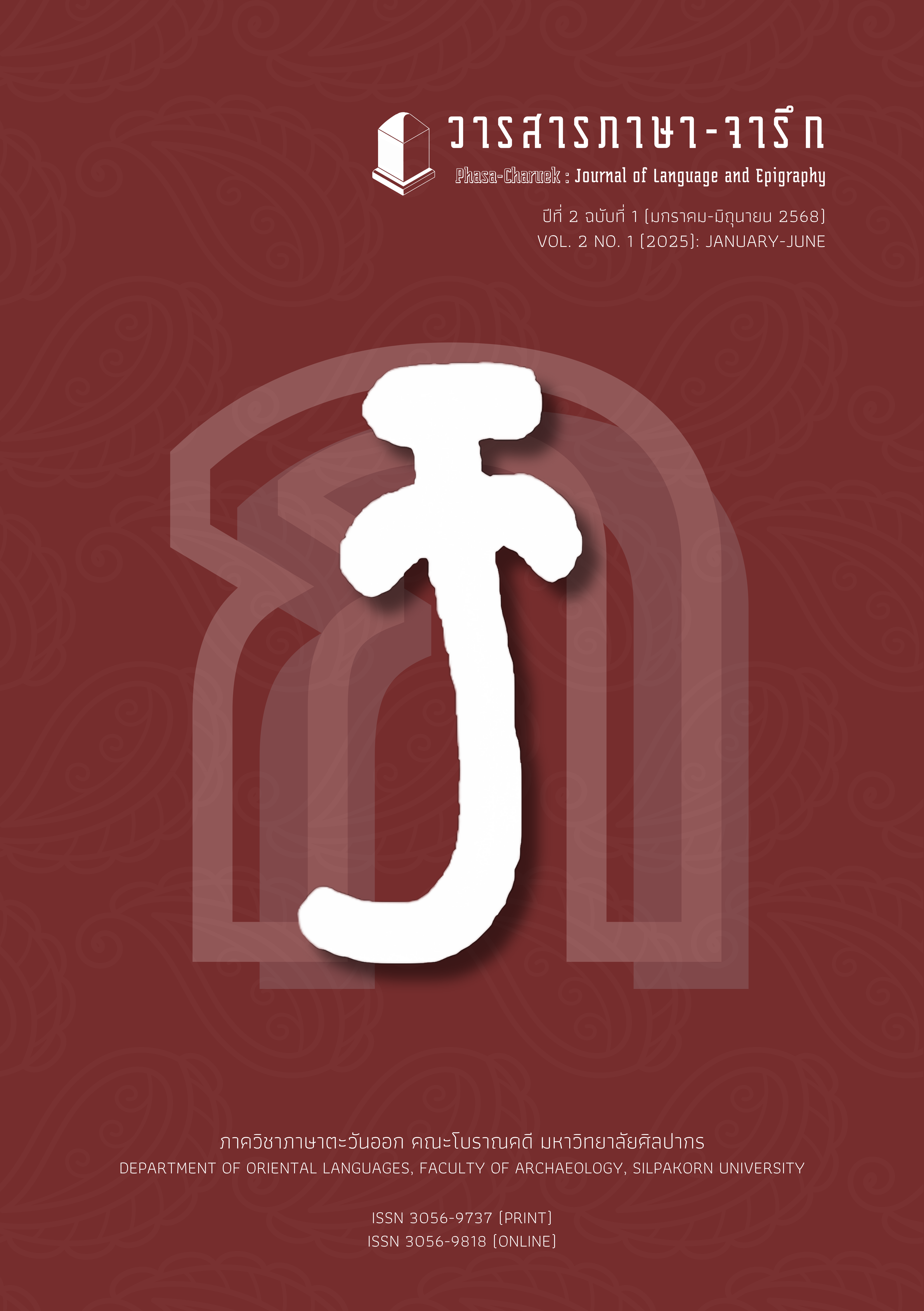กลวิธีการแปลสามมิติของคัมภีร์จีนโบราณ: การวิเคราะห์วาทกรรมพหุรูปแบบในหนังสือการ์ตูน “เหลาจื่อสอนว่า” ฉบับภาษาจีนและภาษาไทย
Main Article Content
บทคัดย่อ
งานวิจัยนี้มีวัตถุประสงค์เพื่อศึกษาและวิเคราะห์กลวิธีการแปลของหนังสือการ์ตูน “เหลาจื่อสอนว่า” ฉบับภาษาจีนและภาษาไทย โดยอาศัยแนวคิดทฤษฎีกลวิธีการแปลสามมิติ (Triadic division of translation) ของโรมัน จาค็อบสัน (Jakobson, 1971; 2000) ผลการศึกษาพบว่า มีการใช้กลวิธี 3 ประเภทหลัก แต่ละกลวิธีประกอบด้วยการใช้กลยุทธ์ 3 ประการย่อย ดังนี้ 1) การแปลภายในภาษาเดียวกัน ได้แก่ 1a) กลยุทธ์การอธิบายข้อมูลเพิ่มเติม 1b) กลยุทธ์การเล่าเรื่อง 1c) กลยุทธ์การสรุปคติสอนใจ 2) การแปลระหว่างสัญญะ ได้แก่ 2a) กลยุทธ์การใช้สัมพันธบทระหว่างภาษาและภาพ 2b) กลยุทธ์การสื่อเกินความจริง 2c) กลยุทธ์การใช้ภาพแทนตัวอักษร 3) การแปลระหว่างภาษา ได้แก่ 3a) กลยุทธ์การแปลแบบทำให้กลมกลืน 3b) กลยุทธ์การแปลแบบรักษาความแปลกต่าง และ 3c) กลยุทธ์การแปลแบบทำให้เสมอกัน เส้นทางการแปลและการสื่อสารในวาทกรรมสื่อพหุรูปแบบที่เป็นหนังสือการ์ตูน “เหลาจื่อสอนว่า” ฉบับภาษาจีนและภาษาไทยประกอบด้วยกระบวนการที่เชื่อมโยงกันอย่างใกล้ชิด 3 กระบวนการ ดังนี้ การแปลภายในภาษาเดียวกัน (จากภาษาจีนโบราณเป็นภาษาจีนปัจจุบัน) การแปลระหว่างภาษา (จากภาษาจีนเป็นภาษาไทย) และการแปลระหว่างสัญญะ (จากข้อความภาษาเป็นการ์ตูน) อย่างไรก็ตาม หนังสือการ์ตูนเรื่อง “เหลาจื่อสอนว่า” ฉบับภาษาจีนที่ประพันธ์โดยไช่จื้อจง และฉบับภาษาไทยที่แปลโดยทองแถม นาถจำนงได้อาศัยวาทกรรมสื่อพหุรูปแบบในการนำเสนอแนวคิดทางสำนักปรัชญาเต๋า ช่วยส่งเสริมการแลกเปลี่ยนข้ามวัฒนธรรมระหว่างประเทศไทยและจีน
Article Details

อนุญาตภายใต้เงื่อนไข Creative Commons Attribution-NonCommercial-NoDerivatives 4.0 International License.
เอกสารอ้างอิง
ภาษาไทย
ทองแถม นาถจำนง. (2531). เหลาจื่อสอนว่า. สำนักพิมพ์ยินหยาง.
ราชบัณฑิตยสถาน. (2556). พจนานุกรมฉบับราชบัณฑิตยสถาน พ.ศ. 2554. กรุงเทพฯ: นานมีบุ๊คส์พับลิเคชั่น.
ลัลลนา ศิริเจริญ. (2518). คู่มือลิลิตยวนพ่าย. พิมพ์ครั้งที่ 3. สำนักพิมพ์อักษรวิทยา.
ภาษาต่างประเทศ
Chen Guying 陈鼓应. (2003). Lao-tzu's Annotation and Translations (老子今注今译). Beijing: The Commercial Press.
Chen Li 陈利. (2015). A Study on the Thai Translations of the Tao Te Ching (《道德经》泰译本研究). Beijing Foreign Studies University (Master's Thesis on Foreign Linguistics and Applied Linguistics).
Feng Youlan 冯友兰. (2011). History of Chinese Philosophy (1) [中国哲学史 (上)]. Beijing: The Commercial Press.
Guan Heyu. et al. (2023). 循道而行:老子思想对现代教育的启示 (Follow the Tao: Enlightenment of Lao Tzu’s Thoughts to Modern Education). Advances in Philosophy 12, 4: 665-670.
Huang Guangzhe & Zhu Lin 黄广哲 & 朱琳. (2018). A Case Study of Intersemiotic Translation Based on Confucius Speaks (以蔡志忠典籍漫画《孔子说》在美国的译介谈 符际翻译). Shanghai Journal of Translators 33, 1: 84-88.
Jakobson, Roman. (1959). “On linguistic aspects of translation.” In On translation, 232-239. Harvard University Press.
Jakobson, Roman. (1971). “On linguistic aspects of translation.” In Jakobson, R. (Ed). Selected Writings 2. Word and Language. The Hague: Mouton 260–266.
Jakobson, Roman. (2000). “On linguistic aspects of translation.” In L. Venuti (Ed.), The translation studies reader 113–118. London/New York: Routledge.
Li Mingyang 李明洋. (2023). A Study of Cai Zhizhong's Comic Art in the Perspective of Oriental Aesthetics (东方美学视野下的蔡志忠漫画艺术研究). North University of China (Master's Thesis on Discipline Theories of Arts Study).
Li Yunxia 李云霞. (2005). An Overview and Comment on Jakobson's Translation Theory: A Review of the Main Theoretical Viewpoints on “On Linguistic Aspects of Translation” (雅各布森翻译理论概述与评论:兼评《论翻译的语言学问题》的主要理论观点). New Angle of View 23, 05: 157-158.
Liang Ping & Zhu Bin 梁萍 & 朱斌. (2023). On the Multimodal Translation of Chinese Traditional Cultural Classics: A Case Study of Chih-Chung Tsai’s The Dao Speaks (Chinese-English) [中国传统文化典籍的多模态翻译探索: 以蔡志忠《老子说》(中英文对照版)为例]. Journal of Heze University 45, 01: 137-142.
Liu Chun 刘春. (2015). Researching on the Spread Situation of Chinese Sinology cartooned taking Cai Zhizhong's work ‘Lao-tzu said’ for instance (国学经典漫画化传播研究). Yunnan University (Master's Thesis on Discipline Theories of Arts Study).
Mao Chunzhou & Li Xiang 毛春洲 & 李翔. (2021). “Water” Metaphor and Its Connotation in Tao Teh Ching from the Perspective of Metaphor Theory (从隐喻理论看《道德经》中水隐喻及其思想内涵). Journal of Hunan University of Science and Technology (Social Science Edition) 24, 3: 184-185.
Nida, E. A., & Taber, C. R. (2004). The Theory and Practice of Translation. Shanghai Foreign Language Education Press. https://doi.org/10.1163/9789004496330
O’Halloran, K. L., Tan, S., & Wignell, P. (2016). Intersemiotic Translation as Resemiotisation: A Multimodal Perspective. Signata. Annales des sémiotiques/Annals of Semiotics, 7, 199-229.
Pan Jiangman 潘江曼. (2011). Study on Tsai Classical Comics under the Aesthetic Perspective (美学视野下的蔡志忠古典漫画研究). Jinan University (Master's Thesis on Philosophy and Aesthetics).
Tsai Chih-Chung 蔡志忠. (1989). The Dao Speaks: Whispers of Wisdom (老子说:智者的低语). Shanghai: SDX Joint Publishing Company.
Venuti, Lawrence. (1995). The Translator's Invisibility: A History of Translation. London & New York: Routledge.
Venuti, Lawrence. (2004). Translator’s Invisibility. Shanghai: Shanghai Foreign Language Education Press.
Venuti, Lawrence. (2001). Strategies of translation. In M. Baker (Ed.), Encyclopedia of Translation Studies, 240–244. London and New York: Routledge.
Wang Liyan 王丽岩. (2016). Translation and Annotation of “Tao Te Ching” (道德经译注). Beijing: China Literary Federation Press.
Wang Yongyan & Fan Yipin 王永炎 & 范逸品. (2024). Significance of Reading Explanations of the Taiji Diagram for Medical Humanities in Medicine (读《太极图说》对人文医学的意义). Tianjin Journal of Traditional Chinese Medicine 41, 05: 545-547.
Wu Di 吴迪. (2011). On the Equivalence Problem in English-Chinese translation from Jakobson's “Semiotics” Theory (从雅各布森的“符号学”理论看英汉互译中的对等问题). Science & Technology Information 18, 28: 170-171.
Wu Zhen 吴震. (2013). The Concept of “Sage” in Chinese Ideological History (中国思想史上的“圣人”概念). Journal of Hangzhou Normal University (Humanities and Social Sciences) 35, 4: 13-25.
Xiao Ping & Zhang Lei 萧平 & 张磊. (2024). On the Historical Evolution and Internal Logic of Taoist “Qi” Concept Before the Wei and Jin Dynasties (论魏晋以前道家“气”观念的历史演变及其内在逻辑). Journal of Wenzhou University (Social Science Edition) 37, 05: 77-87.
Xin Hongjuan & Gao Bing 辛红娟 & 高圣兵. (2008). Diachronic Description of Tao Te Ching in the English World (追寻老子的踪迹:《道德经》英语译本的历时描述). Journal of Nanjing Agricultural University (Social Sciences Edition) 8, 01: 79-84.
Yang Xiangrong & Huang Pei 杨向荣 & 黄培. (2014). Intertextuality between Texts and Images in Graphic Narratives: An Exploration of the Relationship between images and texts based on Chih-Chung Tsai's comics (图像叙事中的语图互文: 基于蔡志忠漫画艺术的图文关系探究). A Hundred Schools of Thought's Review 3, 4: 86-89.
Yao Liwen 姚丽文. (2015). Translation Strategies of Folk Culture Vocabulary from the Perspective of Communication: the Optimal Combination of Foreignization, Domestication and Equalization (传播学视角下的民俗文化词汇翻译策略:异化、归化与等化之优化组合). Journal of Changchun University of Science and Technology (Social Sciences Edition) 28, 03: 102-105.
Zhan Jianfeng 詹剑峰. (2006). Lao-tzu, Person, Book, and His Theory of Taoism (老子其人其书及其道论). Wuhan: Central China Normal University Press.
Zhang Songru 张松如. (1998). Lao-tzu Explanation (老子说解). Jinan: QiLu Press.
Zhang Zhizhong 张智中. (2005). A Dialectical View on Foreignization and Domestication (兼容并蓄双层操作:异化归化之我见). Language and Translation 82, 2: 44-48.
Zhang Jianwei 张剑伟. (2017). The Definition of Tao in Lao-tzu and New Interpretations of its Partial Texts (《老子》之道的定义及部分经文新释). Journal of Peking University (Philosophy and Social Sciences) 54, 03: 86-92.
Zhao Yu 赵玉. (2023). On an New Explanation of “Dao Ke Dao, Fei Chang Dao” (“道可道,非常道”新解). Journal of Qilu Normal University 38, 03: 69-76 and 139.
Zeng Lei & Yu Hui 曾蕾 & 于晖. (2022). Linguistics to Image Text from the Perspective of Functional-Context Translation: A Case Study of Projection in Dao De .Jing and The Dao Speaks (从言语到图文的功能语境翻译探讨: 以《道德经》和《老子说》中的投射为例). Functional Approaches to Translation Studies 1, 01: 73-90.


